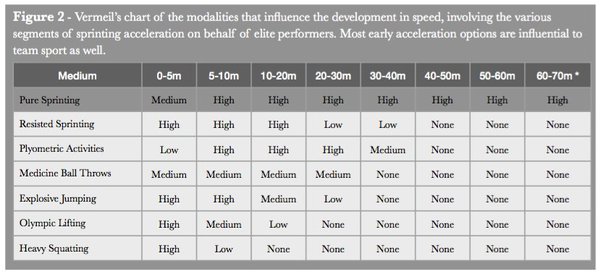
The immediate response whenever an article has a title like this usually is:
“Great someone else trying to ruin Louis’ methods with their take on Westside.”
I agree with you. Most times that’s what happens, and there ends up being some mashup of what someone thinks Westside training looks like with what you can actually fit into the 45 minute period three times per week that you have with athletes to train. Next thing you know you are looking at your workout, adding heavy squats back in, and then erasing the “Dynamic Effort” header from it so that you don’t have to answer any questions about what that means.
My aim is not to imitate anything from Westside except for categorizing workouts into max effort and dynamic effort. Remember that your athletes are not powerlifters, so that 12x3 box squats at 45% with 20% band weight with a cambered bar may not be what they need to perform on the field. Yes, I am speaking from experience (read: I’ve programmed it) so don’t think I’m exaggerating just to attack the strongest people on the planet.
Before we get started, let’s get some information out in the open so that you can follow along as I show you how I go about creating these workouts. Whenever I start putting together different training programs there are always a few places that I will look for information, the one you will see today is from strength coaching Hall of Famer Al Vermeil. If you don’t know Al Vermeil, do yourself a favor and go on Google and do some research. You’ll be thankful you did.
RECENT: The Pyramids of Giza: A Prowler Challenge
The point of focus for setting up a dynamic effort day, in my opinion, is the Vermeil chart shown below that looks at what effect different exercises have on segments of sprinting acceleration.
 Valle, C. (2013). Kinetics Manual [Education Handbook]. Retrieved from http://www.spikesonly.com
Valle, C. (2013). Kinetics Manual [Education Handbook]. Retrieved from http://www.spikesonly.com
If you have never seen this chart take another look and use some time to digest it. As you scan through the chart you may notice a couple of points of interest. First, there are only two modalities that have a high effect on 20 meter or longer sprinting (pure sprinting and plyometric exercise). Second, most exercises usually performed in the weight room are all about working on the first 0-10 meters.
This is probably nothing new to you and that’s fine, but as you study the chart you can start to see how you would build a program around it. Just begin to answer simple questions like:
- Do my athletes need acceleration for 0-5 meters? (Should be yes for almost all cases.)
- Where else do they spend most of their time?
- What exercises do I need to focus on?
If you answer those three questions then you are well on your way to creating a dynamic effort day that is specific for your population. I train athletes that are running no more than 30 meters in a straight line (that’s about 98 feet for those of you that despise the metric system) which means that I need to focus primarily on strengthening the 0-20 meter range. My pre-season conditioning will be built around sprinting of different lengths anyways, so that will cut into plyometric volume of the workout at that time, but until we get towards the end of the off-season I keep plyometric work in my dynamic routines.
The day sets up like this:
No matter how you categorize the exercises the focus remains the same: SPEED! The athlete knows from rep one of exercise one what the goal is today. I have categorized the exercises by velocity for those that want to use a tracking system for feedback and for an easy way to plug different exercises into the slots. I have found that what I call “speed-repetition” (you can call it what you like) is performed best when I place it third. Whether it is due to CNS activation by the previous two or not, I have found that ground contact time during jump series diminishes when done third. Also I am sure that you have noticed the descending sets throughout the workout. This is a method that I have stolen from Joe Kenn and his Tier System that works extremely well.
MORE: RMU Strength and Speed Conference Recap
The two weakness exercises I find are imperative to include no matter what the day. Weaknesses need to be addressed and this is also a place where you can individualize the workout by player or position if you prefer. I like the freedom to have a template built that I can plug in different variations as I feel they are needed.
So looking at the workout in comparison to Vermeil’s chart, you can see that I have included:
- Explosive Jumping – 0-10 meters
- Olympic Lifting – 0-5 meters
- Plyometric Activities – 5-30 meters
- Resisted Sprinting – 0-20 meters
The repetitions and sets are not set in stone here and change from week to week depending on what percentages we are working with and how an athlete is progressing. The clean pulls could easily be replaced with some type of box squatting or banded pulls if you prefer. All of these exercises are performed in supersets with three sets of some type of corrective, mobility, scap work, stability/core exercise, or grip training. The prowler is used for resisted sprints but you can also throw in some hills or old school partner resisted sprints if these are not available to you. As we get closer to the pre-season the sprinting will become less resisted. When pure sprinting comes into play I would recommend doing that first prior to your workout as that is now the priority.
There are hundreds of ways that you will be able to change this workout to work for you and your athletes but always keep in mind the purpose of the day and what goals you have for it. If you begin to find yourself straying towards a hybrid that isn’t purely dynamic effort, go back to the categories and start again. Stay true to the day and make your athletes move faster!
Currently in his third year as a Strength & Conditioning Coach for the Pittsburgh Pirates organization after assisting at The Ohio State University with multiple sports. Previous to working with the Buckeyes, Cory was a Graduate Assistant of Strength & Conditioning at the University of Central Oklahoma where he assisted with all fourteen varsity sports and completed his M.S. in Exercise Science. Cory has a playing background in baseball at Radford University where he received a B.S. in Sports Medicine.











1 Comment